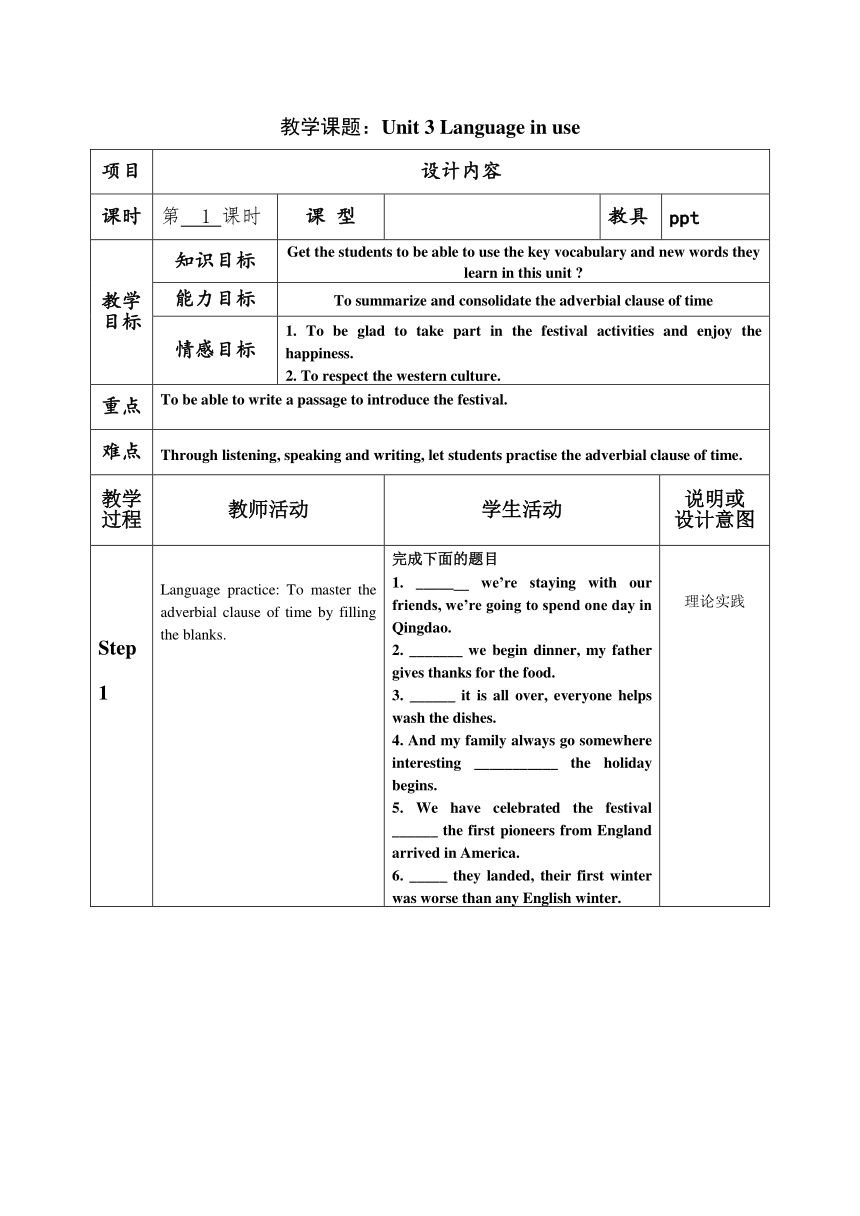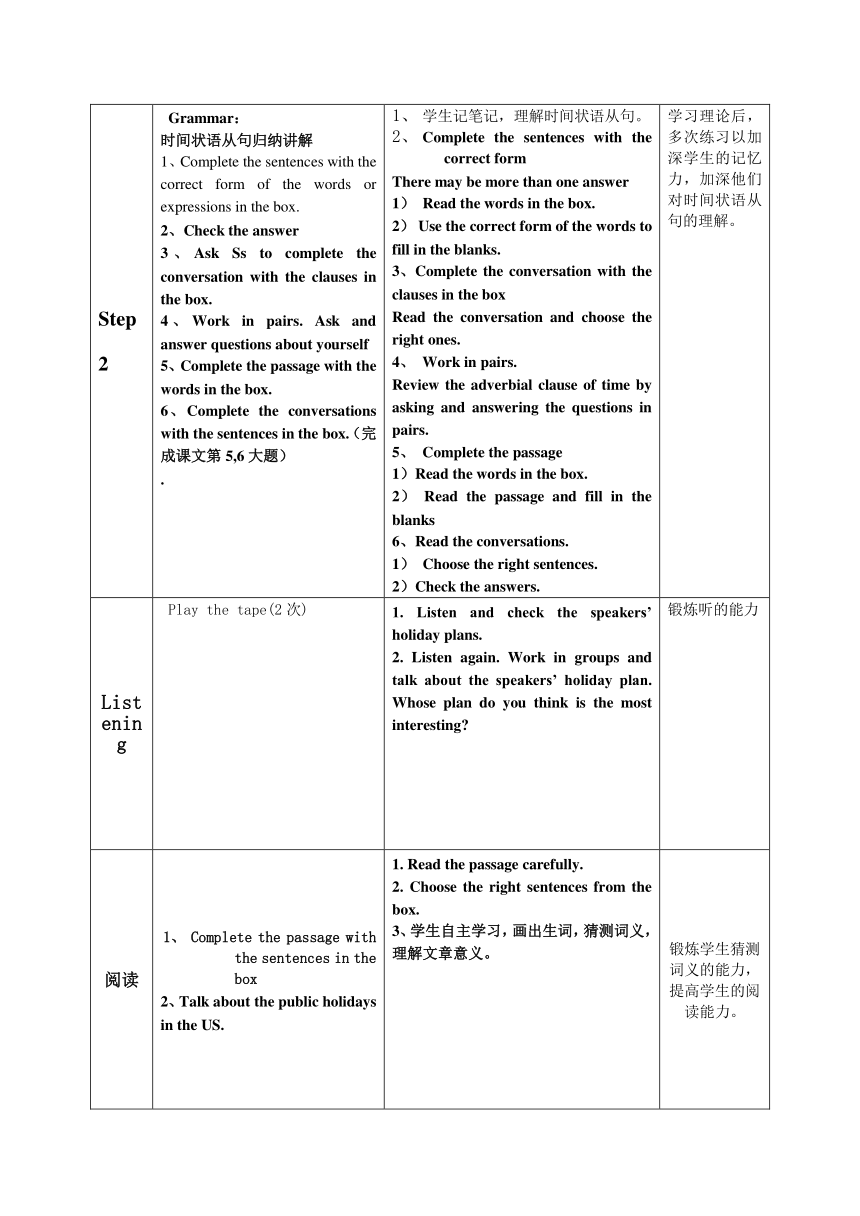Module 2 Public holidays Unit 3 Language in use 表格式教案
文档属性
| 名称 | Module 2 Public holidays Unit 3 Language in use 表格式教案 |  | |
| 格式 | zip | ||
| 文件大小 | 15.0KB | ||
| 资源类型 | 教案 | ||
| 版本资源 | 外研版 | ||
| 科目 | 英语 | ||
| 更新时间 | 2016-11-11 21:43:34 | ||
图片预览


文档简介
教学课题:Unit
3
Language
in
use
项目
设计内容
课时
第
1
课时
课
型
教具
ppt
教学目标
知识目标
Get
the
students
to
be
able
to
use
the
key
vocabulary
and
new
words
they
learn
in
this
unit
能力目标
To
summarize
and
consolidate
the
adverbial
clause
of
time
情感目标
1.
To
be
glad
to
take
part
in
the
festival
activities
and
enjoy
the
happiness.2.
To
respect
the
western
culture.
重点
To
be
able
to
write
a
passage
to
introduce
the
festival.
难点
Through
listening,
speaking
and
writing,
let
students
practise
the
adverbial
clause
of
time.
教学过程
教师活动
学生活动
说明或设计意图
Step
1
Language
practice:
To
master
the
adverbial
clause
of
time
by
filling
the
blanks.
完成下面的题目1.
_______
we’re
staying
with
our
friends,
we’re
going
to
spend
one
day
in
Qingdao.2.
_______
we
begin
dinner,
my
father
gives
thanks
for
the
food.3.
______
it
is
all
over,
everyone
helps
wash
the
dishes.4.
And
my
family
always
go
somewhere
interesting
___________
the
holiday
begins.5.
We
have
celebrated
the
festival
______
the
first
pioneers
from
England
arrived
in
America.6.
_____
they
landed,
their
first
winter
was
worse
than
any
English
winter.
理论实践
Step
2
Grammar:时间状语从句归纳讲解1、Complete
the
sentences
with
the
correct
form
of
the
words
or
expressions
in
the
box.2、Check
the
answer3、Ask
Ss
to
complete
the
conversation
with
the
clauses
in
the
box.4、Work
in
pairs.
Ask
and
answer
questions
about
yourself5、Complete
the
passage
with
the
words
in
the
box.6、Complete
the
conversations
with
the
sentences
in
the
box.(完成课文第5,6大题).
学生记笔记,理解时间状语从句。Complete
the
sentences
with
the
correct
formThere
may
be
more
than
one
answer1)
Read
the
words
in
the
box.2)
Use
the
correct
form
of
the
words
to
fill
in
the
blanks.3、Complete
the
conversation
with
the
clauses
in
the
boxRead
the
conversation
and
choose
the
right
ones.Work
in
pairs.Review
the
adverbial
clause
of
time
by
asking
and
answering
the
questions
in
plete
the
passage1)Read
the
words
in
the
box.2)
Read
the
passage
and
fill
in
the
blanks6、Read
the
conversations.1)
Choose
the
right
sentences.2)Check
the
answers.
学习理论后,多次练习以加深学生的记忆力,加深他们对时间状语从句的理解。
Listening
Play
the
tape(2次)
1.
Listen
and
check
the
speakers’
holiday
plans.2.
Listen
again.
Work
in
groups
and
talk
about
the
speakers’
holiday
plan.
Whose
plan
do
you
think
is
the
most
interesting
锻炼听的能力
阅读
Complete
the
passage
with
the
sentences
in
the
box2、Talk
about
the
public
holidays
in
the
US.
1.
Read
the
passage
carefully.2.
Choose
the
right
sentences
from
the
box.3、学生自主学习,画出生词,猜测词义,理解文章意义。
锻炼学生猜测词义的能力,提高学生的阅读能力。
作业布置
完成同步练习册描写中国传统节日—春节
板书设计
Adverb
Clauses
of
Time(时间状语从句)用来修饰谓语动词、其他动词、定语、状语或整个句子的从句叫状语从句。状语从句有很多种,今天我们主要学习由when,
while,
before,
after,
as
soon
as,
since,
until引导的时间状语从句。when从句的动作可与主句的动作同时发生,也可先于主句的动作;从句的谓语动词可以是延续性动词,也可以是瞬间性动词。并且when有时意为“就在那时”When
I
got
home,
he
was
watching
TV.
当我到家的时候,他正在看电视。1、when和while
的区别
:when
引导的时间状语从句,
谓语动词既可以是持续性的,
也可以是终止性的;而while引导的时间状语从句,
谓语动词只能是持续性的,
并且常用进行时态。When he woke up,
it was eight o’clock.√
While he woke up,
it was eight o’clock.×
When I was waiting for a bus,
I met her.√While I was waiting for a bus,
I met her.√2、before表示主句的动作发生在从句之前。如:
I
won’t
tell
you
the
truth
before
he
comes
back.
他回来之前我是不会告诉你事实的。◆as
soon
as表示主句的动作紧随从句动作之后发生的。表示“一……就”。如:
I
will
call
you
as
soon
as
I
arrive
home.
我一到家就给你打电话。◆until(till)在肯定句中,常与延续性动词连用,意为“到……为止”;在否定句中,常与表示瞬间性动作的动词连用,意为“直到……才”,这时till
和until可以与before
替换。如:Last
night
I
waited
until
eleven
o’clock,
but
he
didn’t
return.
昨天晚上我一直等到11点,
但他还没回来。
My
son
won’t
come
home
until
it
is
dark.
我儿子不到天黑不回家。
课后反思
3
Language
in
use
项目
设计内容
课时
第
1
课时
课
型
教具
ppt
教学目标
知识目标
Get
the
students
to
be
able
to
use
the
key
vocabulary
and
new
words
they
learn
in
this
unit
能力目标
To
summarize
and
consolidate
the
adverbial
clause
of
time
情感目标
1.
To
be
glad
to
take
part
in
the
festival
activities
and
enjoy
the
happiness.2.
To
respect
the
western
culture.
重点
To
be
able
to
write
a
passage
to
introduce
the
festival.
难点
Through
listening,
speaking
and
writing,
let
students
practise
the
adverbial
clause
of
time.
教学过程
教师活动
学生活动
说明或设计意图
Step
1
Language
practice:
To
master
the
adverbial
clause
of
time
by
filling
the
blanks.
完成下面的题目1.
_______
we’re
staying
with
our
friends,
we’re
going
to
spend
one
day
in
Qingdao.2.
_______
we
begin
dinner,
my
father
gives
thanks
for
the
food.3.
______
it
is
all
over,
everyone
helps
wash
the
dishes.4.
And
my
family
always
go
somewhere
interesting
___________
the
holiday
begins.5.
We
have
celebrated
the
festival
______
the
first
pioneers
from
England
arrived
in
America.6.
_____
they
landed,
their
first
winter
was
worse
than
any
English
winter.
理论实践
Step
2
Grammar:时间状语从句归纳讲解1、Complete
the
sentences
with
the
correct
form
of
the
words
or
expressions
in
the
box.2、Check
the
answer3、Ask
Ss
to
complete
the
conversation
with
the
clauses
in
the
box.4、Work
in
pairs.
Ask
and
answer
questions
about
yourself5、Complete
the
passage
with
the
words
in
the
box.6、Complete
the
conversations
with
the
sentences
in
the
box.(完成课文第5,6大题).
学生记笔记,理解时间状语从句。Complete
the
sentences
with
the
correct
formThere
may
be
more
than
one
answer1)
Read
the
words
in
the
box.2)
Use
the
correct
form
of
the
words
to
fill
in
the
blanks.3、Complete
the
conversation
with
the
clauses
in
the
boxRead
the
conversation
and
choose
the
right
ones.Work
in
pairs.Review
the
adverbial
clause
of
time
by
asking
and
answering
the
questions
in
plete
the
passage1)Read
the
words
in
the
box.2)
Read
the
passage
and
fill
in
the
blanks6、Read
the
conversations.1)
Choose
the
right
sentences.2)Check
the
answers.
学习理论后,多次练习以加深学生的记忆力,加深他们对时间状语从句的理解。
Listening
Play
the
tape(2次)
1.
Listen
and
check
the
speakers’
holiday
plans.2.
Listen
again.
Work
in
groups
and
talk
about
the
speakers’
holiday
plan.
Whose
plan
do
you
think
is
the
most
interesting
锻炼听的能力
阅读
Complete
the
passage
with
the
sentences
in
the
box2、Talk
about
the
public
holidays
in
the
US.
1.
Read
the
passage
carefully.2.
Choose
the
right
sentences
from
the
box.3、学生自主学习,画出生词,猜测词义,理解文章意义。
锻炼学生猜测词义的能力,提高学生的阅读能力。
作业布置
完成同步练习册描写中国传统节日—春节
板书设计
Adverb
Clauses
of
Time(时间状语从句)用来修饰谓语动词、其他动词、定语、状语或整个句子的从句叫状语从句。状语从句有很多种,今天我们主要学习由when,
while,
before,
after,
as
soon
as,
since,
until引导的时间状语从句。when从句的动作可与主句的动作同时发生,也可先于主句的动作;从句的谓语动词可以是延续性动词,也可以是瞬间性动词。并且when有时意为“就在那时”When
I
got
home,
he
was
watching
TV.
当我到家的时候,他正在看电视。1、when和while
的区别
:when
引导的时间状语从句,
谓语动词既可以是持续性的,
也可以是终止性的;而while引导的时间状语从句,
谓语动词只能是持续性的,
并且常用进行时态。When he woke up,
it was eight o’clock.√
While he woke up,
it was eight o’clock.×
When I was waiting for a bus,
I met her.√While I was waiting for a bus,
I met her.√2、before表示主句的动作发生在从句之前。如:
I
won’t
tell
you
the
truth
before
he
comes
back.
他回来之前我是不会告诉你事实的。◆as
soon
as表示主句的动作紧随从句动作之后发生的。表示“一……就”。如:
I
will
call
you
as
soon
as
I
arrive
home.
我一到家就给你打电话。◆until(till)在肯定句中,常与延续性动词连用,意为“到……为止”;在否定句中,常与表示瞬间性动作的动词连用,意为“直到……才”,这时till
和until可以与before
替换。如:Last
night
I
waited
until
eleven
o’clock,
but
he
didn’t
return.
昨天晚上我一直等到11点,
但他还没回来。
My
son
won’t
come
home
until
it
is
dark.
我儿子不到天黑不回家。
课后反思
同课章节目录
- Module 1 Wonders of the world
- Unit 1 It's more than 2,000 years old.
- Unit 2 The Grand Canyon was not just big.
- Unit 3 Language in use
- Module 2 Public holidays
- Unit 1 My family always go somewhere interesting a
- Unit 2 We have celebrated the festival since the f
- Unit 3 Language in use
- Module 3 Heroes
- Unit 1 She trained hard,so she became a great play
- Unit 2There were few doctors, so he had to work ve
- Unit 3 Language in use
- Module 4 Home alone
- Unit 1 I can look after myself, although it won’t
- Unit 2 I became so bored with their orders that I
- Unit 3 Language in use
- Module 5 Museums
- Unit 1 Don't cross that rope!
- Unit 2 If you ever go to London, make sure you vis
- Unit 3 Language in use
- Module 6 Problems
- Unit 1 If I start after dinner, I'll finish it be
- Unit 2 If you tell him the truth now, you will sho
- Unit 3 Language in use
- Revision Module A
- Module 7 Great books
- Unit 1 We're still influenced by Confucius's idea
- Unit 2 It is still read and loved.
- Unit 3 Language in use
- Module 8 Sports life
- Unit 1 Daming wasn't chosen for the team last time
- Unit 2 He was invited to competitions around the w
- Unit 3 Language in use
- Module 9 Great inventions
- Unit 1 Will computers be used more than books in t
- Unit 2 Will books be replaced by the Internet?
- Unit 3 Language in use
- Module 10 Australia
- Unit 1 I have some photos that I took in Australia
- Unit 2 The game that they like most is Australian
- Unit 3 Language in use
- Module 11 Photos
- Unit 1 He's the boy who won the photo competition
- Unit 2 The photo which we liked best was taken by
- Unit 3 Language in use
- Module 12 Save our world
- Unit 1 If everyone starts to do something, the wor
- Unit 2 Repeat these three words daily: reduce, reu
- Unit 3 Language in use
- Revision Module B
